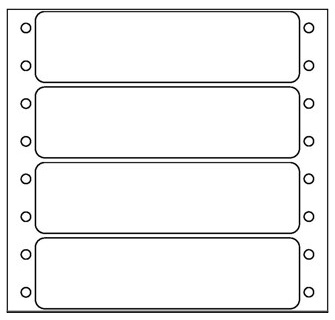Recognizing How Blank Labels Job to Improve Your Labeling Experience
Recognizing the mechanics of blank labels is important for optimizing your labeling practices throughout different contexts. To totally understand exactly how these labels can change your processes, one should think about the various types offered and the myriad methods they can be personalized to fit certain demands.

Advantages of Utilizing Blank Labels
Blank labels offer a flexible solution for different labeling requirements, making them important in both individual and specialist settings. Their versatility permits individuals to develop customized labels customized to specific demands, boosting organizational efficiency. Whether made use of in home offices, retail atmospheres, or commercial applications, blank labels help with the recognition and classification of products, files, and individual items.
One substantial advantage of blank labels is their cost-effectiveness. By allowing users to print only the labels they need, waste is lessened, and supply monitoring becomes much more workable. In addition, blank labels are suitable with various printing methods, including inkjet and laser printers, making them available for different individuals.

Furthermore, making use of blank labels simplifies the procedure of updating information, as users can quickly print brand-new labels to change outdated ones, guaranteeing that all items and papers are accurately labeled. Overall, blank labels give a practical and reliable labeling remedy for varied applications.
Sorts Of Blank Labels Available
What alternatives are available when it comes to blank labels? Blank labels come in a range of kinds, each suited for different applications and preferences.
An additional popular option is synthetic labels, frequently made from materials like polyester or vinyl. These labels are understood for their resilience and resistance to water, chemicals, and tearing, making them ideal for rough environments. They are generally used in industrial settings or for labeling items that may be exposed to wetness.
Furthermore, there are thermal transfer labels, which need a printer that utilizes warm to move ink onto the label surface area. These labels are favored for their top quality print and durability.
Finally, specialty labels satisfy specific demands, such as detachable labels for momentary usage or high-temperature labels for severe conditions. Comprehending these alternatives permits individuals to select the most ideal blank tag for their one-of-a-kind labeling requirements.
Customization Options for Labels
A large range of personalization choices is offered for labels, permitting users to customize them to specific requirements and branding requirements. Individuals can pick from numerous sizes, shapes, and products to guarantee that the labels efficiently fit their intended objective. Usual products include paper, polyester, and plastic, each providing various levels of resilience and visual charm.
Color choices play a vital role in modification, enabling brand names to maintain uniformity with their corporate identification. Users can select from a spectrum of colors or also go with personalized printing to match certain branding elements. Furthermore, labels can be published with distinct layouts, logos, and text, boosting brand recognition and aesthetic impact.
One more important element is the selection go to website of adhesive. Labels can be developed with irreversible, removable, or repositionable adhesives, depending upon the application needs. This flexibility enables reliable labeling solutions across different settings, from retail to industrial settings.

Tips for Effective Labeling
Reliable labeling goes beyond modification; it likewise involves calculated factors to consider that enhance performance and communication. To attain effective labeling, start by clearly specifying the purpose of each label.
Following, prioritize presence by choosing ideal colors and typefaces. High contrast in between click to read message and background boosts readability, while larger font styles facilitate quick recognition. Additionally, make sure that labels are positioned in a constant and sensible manner, making it much easier for users to find and analyze information.
Take into consideration the resilience of labels. Select products suited for the certain setting where the labels will be utilized, whether it be inside or outdoors. Water-proof or tear-resistant options may be essential depending on the context.
Lastly, consistently review and update your labels to reflect any type of adjustments in details or usage. This proactive technique not just keeps clarity but likewise prevents complication with time. By following these suggestions, you can make best use of the effectiveness of your labeling efforts, ensuring they serve their intended purpose efficiently.
Applications of Blank Labels
Blank labels provide many applications throughout numerous sectors, making them an invaluable tool for organization and interaction. These functional labels are commonly used in storage facilities for inventory administration, enabling services to conveniently recognize and track items. By applying blank labels to storage bins, racks, or pallets, firms can enhance their procedures and decrease the possibility of errors.
In the healthcare field, blank labels play an essential duty link in identifying medicines and medical products, making certain appropriate identification and use. Personalized labels can consist of important details such as dose, expiry days, and patient information, boosting safety and compliance.
In retail, blank labels help in pricing products, offering promos, or identifying rack areas, which eventually enhances the customer experience. They allow for fast updates to rates or product information without the requirement for pre-printed labels.
Additionally, blank labels are advantageous for individual use, such as arranging office, crafting, or classifying food containers. Their versatility permits individuals to develop tailored remedies that meet details requirements. On the whole, the applications of blank labels are substantial, emphasizing their significance in cultivating effectiveness and quality in various setups.
Conclusion
In conclusion, blank labels present a flexible and efficient option for numerous classifying needs. Ultimately, the combination of blank labels into operational processes contributes to enhanced effectiveness, making them a very useful source for both individual and professional usage.